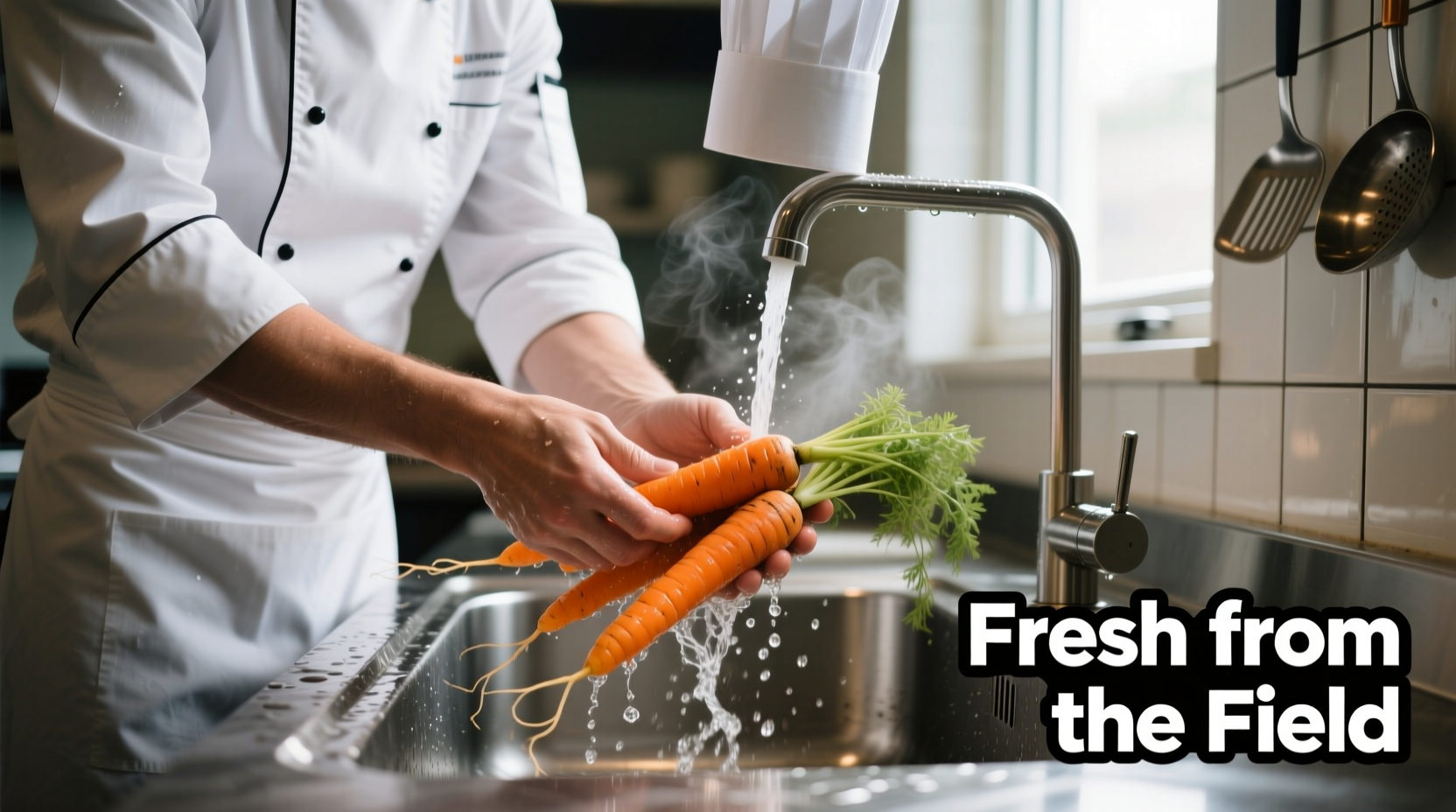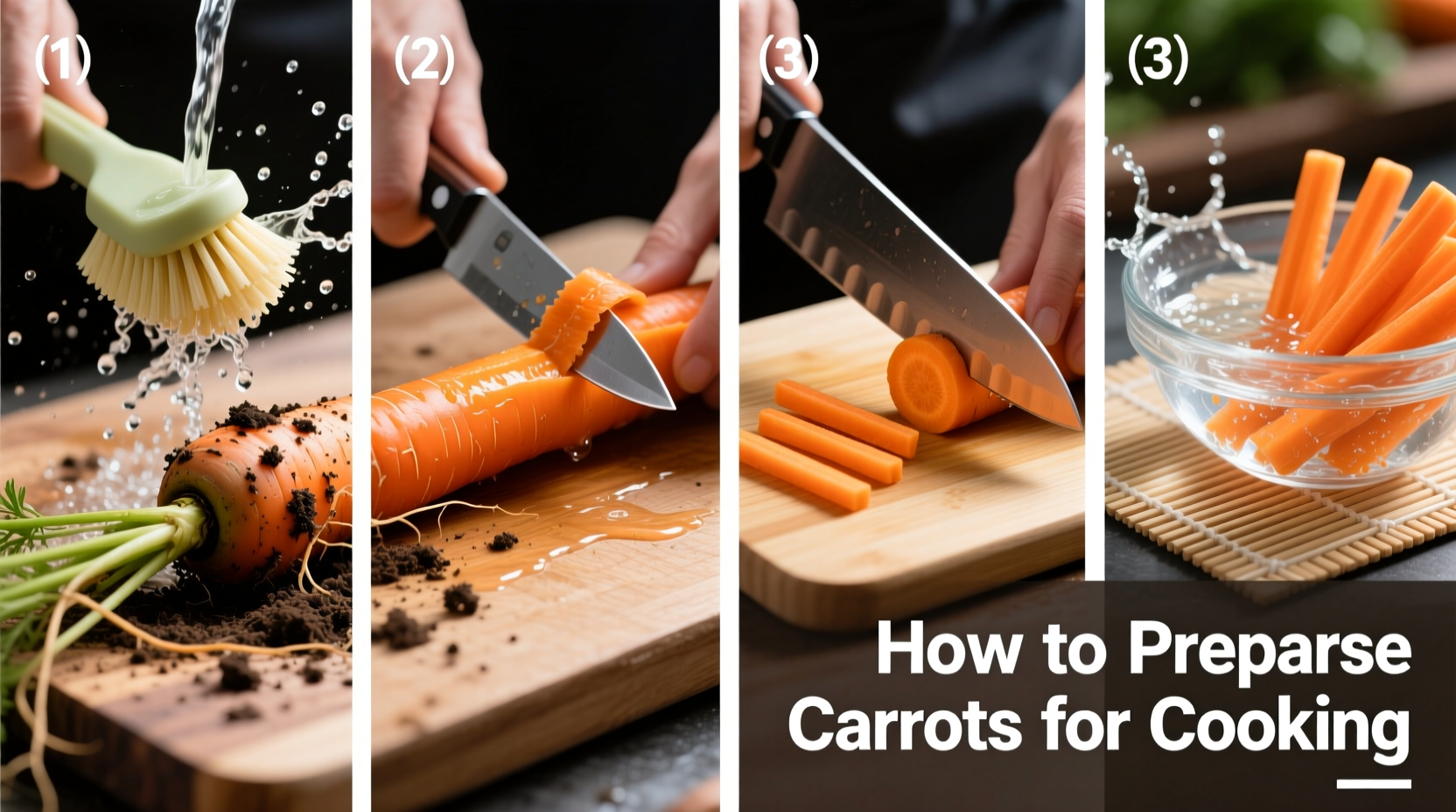Essential Tools for Carrot Preparation
Before you begin, gather these kitchen essentials:
- Vegetable brush (for effective cleaning)
- Sharp paring knife or vegetable peeler
- Stable cutting board
- Bowl of cold water
- Colander for draining

Step 1: Cleaning Carrots Properly
Carrots grow underground and often carry significant dirt. Proper cleaning prevents grit in your finished dish. Start by removing leafy tops (if attached) about 1/4 inch above the crown to prevent moisture loss. The FDA recommends washing produce under running water, not soaking, to minimize cross-contamination.
Hold each carrot under cool running water while scrubbing with a vegetable brush. Pay special attention to crevices near the stem end. For particularly dirty carrots, use a soft-bristled brush to remove stubborn soil without damaging the skin. Never use soap or detergent on produce.
Step 2: To Peel or Not to Peel?
Whether to peel carrots depends on several factors. Young, thin-skinned carrots often don't require peeling if properly cleaned. However, older or thicker-skinned varieties benefit from peeling to improve texture. The University of Minnesota Extension notes that peeling removes about 10-15% of nutrients found just beneath the skin.
| Peeling Method | Best For | Time Required | Nutrient Retention |
|---|---|---|---|
| Vegetable peeler | Most cooking applications | 2-3 minutes per pound | Moderate (removes outer layer) |
| Knife peeling | Irregularly shaped carrots | 3-4 minutes per pound | Lowest (removes more flesh) |
| No peeling | Roasting, young carrots | 1 minute per pound | Highest (retains skin nutrients) |
Step 3: Cutting Techniques for Different Cooking Methods
The way you cut carrots significantly impacts cooking time and texture. Professional chefs select cuts based on the cooking method:
Uniform Slicing for Even Cooking
For soups and stews, cut carrots into 1/4-inch rounds. For roasting, create 2-inch batons (sticks) of equal thickness to ensure even cooking. When preparing carrots for stir-fries, use the diagonal cut technique - this creates oval pieces with more surface area that cook faster and absorb flavors better.
Specialty Cuts
Julienne: For salads or garnishes, cut carrots into thin matchsticks (1/8 inch thick). Chiffonade: When using carrot greens (if fresh), stack leaves and roll tightly before slicing into thin ribbons. Turné: For formal presentations, professional chefs create seven-sided oval shapes that cook evenly and look elegant.
Step 4: Special Preparation Methods
Different cooking techniques require specific preparation approaches:
Blanching Before Freezing
If preparing carrots for long-term storage, blanching preserves color and texture. Boil cleaned, cut carrots for 2-3 minutes, then immediately plunge into ice water. This process deactivates enzymes that cause spoilage. According to agricultural research from Kansas State University, blanching improves frozen carrot quality by 40-60% compared to raw freezing.
Preventing Browning
Carrots contain enzymes that cause discoloration when cut. To prevent this during meal prep, submerge cut pieces in cold water with a tablespoon of lemon juice or vinegar per quart. This acidulated water creates a barrier against oxidation without affecting flavor.
Step 5: Storage Solutions for Prepared Carrots
Proper storage extends the life of prepared carrots:
- Refrigerate cut carrots in airtight containers with a damp paper towel (lasts 3-5 days)
- Submerge in cold water in a sealed container (change water daily, lasts up to 1 week)
- For longer storage, freeze blanched pieces in freezer bags (maintains quality for 10-12 months)
Never store prepared carrots near ethylene-producing fruits like apples or bananas, as this accelerates spoilage. The ideal storage temperature is 32-36°F (0-2°C) with high humidity.
Avoiding Common Carrot Preparation Mistakes
Many home cooks make these errors that compromise carrot quality:
- Peeling too thickly - removes valuable nutrients just beneath the skin
- Cutting uneven pieces - causes some pieces to overcook while others remain hard
- Not trimming ends properly - leaves bitter-tasting portions in your dish
- Soaking too long - causes waterlogging and flavor loss
Professional chefs recommend leaving about 1/4 inch of stem and root ends before final trimming. This prevents the carrot from becoming waterlogged during cleaning while removing the most bitter portions.
When Preparation Methods Vary by Carrot Type
Not all carrots prepare the same. Understanding variety differences improves results:
- Nantes carrots (common supermarket variety): Thin skin, often doesn't require peeling
- Imperator carrots (long, tapered): Thicker skin, benefits from light peeling
- Chantenay carrots (short, stout): Often used for canning, best peeled
- Heirloom varieties (purple, white, yellow): Delicate skin, usually not peeled
Context matters significantly - for purees, thorough peeling creates smoother texture, while for rustic roasting, leaving skin on adds visual appeal and nutrients. The culinary research organization Culinary Institute of America notes that skin-on roasting increases fiber content by approximately 20% compared to peeled carrots.
FAQ Section
Can you cook carrots without peeling them?
Yes, you can cook carrots without peeling if they're young and properly cleaned. Thoroughly scrub the skin with a vegetable brush under running water to remove dirt. Unpeeled carrots retain more nutrients and add visual interest to dishes, particularly when roasting or using in rustic preparations.
How do you prevent carrots from becoming mushy when cooking?
To prevent mushy carrots, cut them to uniform sizes for even cooking, avoid overcooking, and consider the cooking method. For boiling, cook until just tender-crisp (about 5-7 minutes for slices). When roasting, cut larger pieces for longer cooking times. Adding a small amount of acid like lemon juice to the cooking water can also help maintain firmness.
What's the best way to store cut carrots?
The best way to store cut carrots is submerged in cold water in an airtight container in the refrigerator. Change the water daily to maintain freshness. This method keeps cut carrots crisp for up to one week. For longer storage, blanch cut pieces for 2-3 minutes, cool in ice water, then freeze in portion-sized bags for up to 12 months.
Why do my carrots taste bitter after cooking?
Carrots can taste bitter if you don't properly trim the ends, as the stem and root portions contain higher concentrations of bitter compounds. Always trim about 1/4 inch from both ends. Overcooking can also create bitter flavors through caramelization of natural sugars. Using older carrots or improper storage before preparation may contribute to bitterness as well.











 浙公网安备
33010002000092号
浙公网安备
33010002000092号 浙B2-20120091-4
浙B2-20120091-4